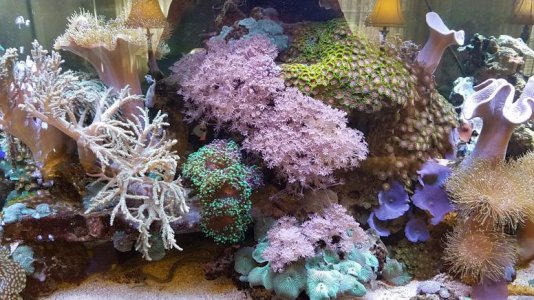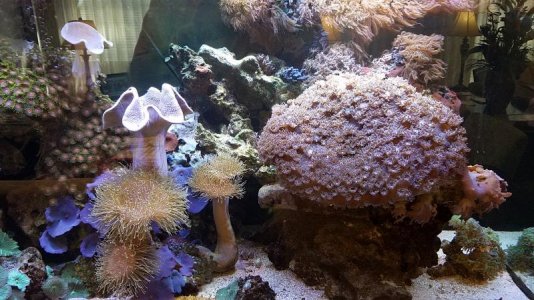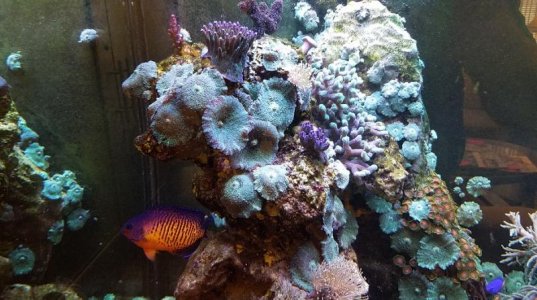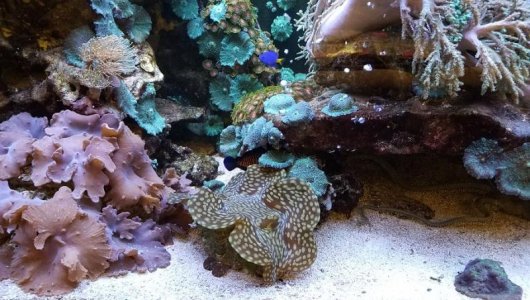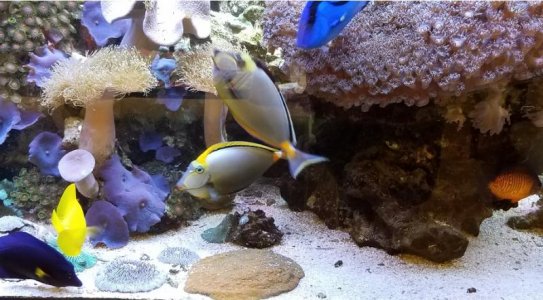Wow, nice looking tank. I've always been told skimmerless systems were only possible on smaller tank, yet, here you have a larger tank that is successfully kept as skimmerless. Thank you for posting. It's nice seeing skimmerless success over a long period of time on such a large tank - motivational actually. . .
Thank you very much!

It's sad you were told that as Dr. Jaubert (building it seems to me, on Lee Chin Eng's methods) demonstrated in the '80s large reef systems could do very well and grow many stoney coral species without pumps, skimmers, GAC, certainly not GFO and without water changes for years. Using, like Lee Chin Eng, just air bubbles for water movement. The caveot I would add now is with what I've read about the role of DOC, which can be divided loosely divided into labile, semi labile and refractory forms, the best way to control the refractory forms is with water changes. See the links in post in #18 above for a better explanation of the roles DOC plays on reefs. Delbeek and Sprung have written about Lee Chin Eng and Dr. Jubert's skimmerless systems in FAMA as well as in their books so it sounds to me as whoever told you that was very poorly read or just stuck in their dogma.

(I think it's noteworthy to point out Sprung's system which has a couple video's on line has been skimmerless since the late '90s. Also, the two oldest corals farmers started in the 90's, Tropicorum in Detroit and Steve Tyree here in Texas stopped using skimmers in the mid-late '90s. Tyree's stuff on ecomorphology is a good place to start with understanding cryptic sumps and predicted the vital roles of sponges proven by Jasper de Goeij's work 10 years ago)
. . .It doesn't look like you have too heavy of a bioload (which is what I would expect with a skimmerless system). Looks like you have a very nice balance. . .
It is a bit on the light side but not because I'm running skimmerless. Corals are much better at dealing with the metabolic waste produced by fish than skimmers are. Current fish include Regal, Naso and Blonde Naso all about 7"-9" long depending on whether you use standard length or total length. Purple Tang (actually older than this system but was rehomed from another system last year), Coral Beauty, Flame Hawk and some damsels. The main reason I maintain lighter fish loads is if there is some kind of failure particularly if there is a long term power failure or AC failure the heavier a system is stocked with fish the quicker animals will start to die off.
(As an aside, there are good battery backup systems designed for aquaria but I really like Penn Plax's air pump that turns on only after power is lost. I have several and they all run at least 4 days with just 2 D cell batteries. There are models by other manufacturers some are ok but one that has a "W" or wave logo molded on top only will turn on about a third of the time. I would not use an UPS designed for electronic equipment, irregardless of the load they will only run an hour or so.)
I must say, given I'm battling a GHA outbreak due to phosphate leaking from my rocks, I'm astounded you have such a clean tank having no filtration. Mine is skimmerless as well, but man. One of these days I hope my tank will be clean like that.
I'm curious if you would think of your problem differently if you knew PO4 levels on reefs on average are .13 mg/l. That only a tiny fraction of reefs have PO4 levels below .05 mg/l. That open ocean surface levels of PO4 away from reefs can be ~.4 mg/l (+/- ~.2) which argues corals are depleting PO4 in the waters surrounding reefs. That reefs at any time may be exposed to PO4 levels of as much as 2 mg/l with upwellings. That PO4 is as essential for photosynthesis in corals as bicarbonate (you've been taught to keep alkalinity above a certain point why not PO4?). That controlled studies of PO4 on the growth of corals shows increasing PO4 increases growth? (It does reduce calcification as well as nitrate above 1 mg/l.) That when a corals internal PO4 level drops to around .07 mg/l it may cause it's zooxanthellae to make sulpher compounds that are toxic to the coral? That all calcium carbonate substrates will be slowly dissolving due to localized low pH and bioeroders releasing PO4 in all systems employing them? That all food has PO4 that's being released into the system?
What has worked for me for a couple decades now when I'm called in to remediate a tank is frequent manual removal and short spine urchins, the royal and tuxedo are my favorites.


